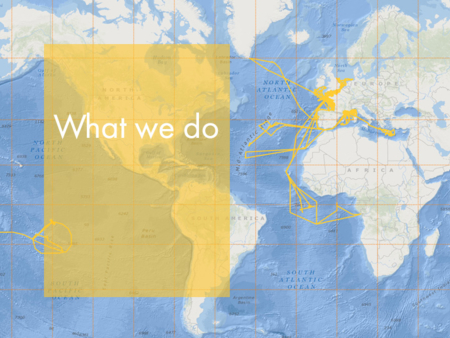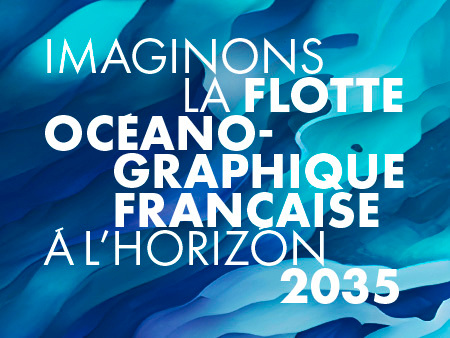1.3. Activity statement for sea campaigns over the last 5 years
The FOF brings together vessels of different sizes with different commissioning costs. The simple addition of days at sea for this collection barely makes sense and any report should be drawn up using uniform sub-categories. The most widely-accepted and most-used segmentation distinguishes between: (1) vessels said to be ocean-going (l>36m), (2) coastal or “in-shore” ships (l<36m), and (3) station ships (l>10m and managed remotely). The latter is differentiated from the other two by the fact that the programming/use unit is not the campaign but the day, or even sometimes a half-day at sea. This clearly makes it complicated to monitor their activity and has led us to discard the activity of this FOF component in the following statement. However, we would like to recall the essential function of this flotilla supporting all activities in French marine stations. The data presented below was compiled on the basis of information provided by the Fleet UMS for the 2011-2016 period.
1.3.1. Number of days of activities and decommissioning periods
Monitoring days of activity per category of use of the FOF is proposed for each year on the UMS FOF site. Table 3 compiles the average values for these days of activity, set between 2011 and 2016. We can see that the 4 major boats (ocean-going fleet) have allowed 586 days of scientific research, 188 days of Public Service and 161 days of public-private partnership. This distribution is theoretically satisfactory, except that the pressure of “scientific research” has suffered a slight drop over the last 5 years. This drop can essentially be attributed to funding difficulties for oceanographic research relying on the TGIR FOF (see section 2.5). For the entire ocean-going fleet, the decommissioning periods correspond on average to 20% of the potential time of use (Table 3 and Figure 11). This figure nevertheless hides a clear difference between vessels. This proportion is actually low (i.e. <10%), or even very low for the Pourquoi pas ?, Atalante and the Marion Dufresne and, on the contrary, significant for the Thalassa (43%) and even more so for the Suroît (71%). In the latter two cases, this shows that the chosen activity period included long stand-down periods for major technical modifications (e.g. renovation of the Suroît) or even a period following definitive decommissioning of the ship (e.g. Suroît). Due to these availability limitations, we might consider that the accumulated figures (e.g. 586 days for scientific research) constitute sub-estimations of the community’s real needs. One important aside concerning the Marion Dufresne refers to the number of operable days for the IPEV (only 217/year). The three vessels with the low or very low stand-down rates are ships for which chartering is most important. This is particularly true for the Pourquoi Pas ? for which the 57 days dedicated on average to chartering take up an important proportion of activity time not attributed to the Navy for this vessel.
As far as the coastal or in-shore fleet is concerned, the annual average activity dedicated to scientific research is 1186 days, plus 164 days of Public Service and 36 days of public-private partnership. The average decommissioning rate rises to 40%, namely double the rate for the ocean-going fleet. Even there, we can see big differences between vessels in terms of technical problems (e.g. Antea) or decommissioning (e.g. Gwen Drez). Nevertheless, it should be highlighted that the lowest decommissioning rate (i.e. 17% for the Téthys) is still quite high. This can very probably be translated as: (1) the absence of significant possibilities for compensation by means of chartering for this component of the FOF, and (2) the existence of a moderator ticket that is likely to have limited demands for use during a significant proportion of the 2011-2016 period, moderator ticket removed during 2016. As for the ocean-going fleet, it is best to consider the figures being presented as underestimations of the real needs: this rather more that the new Public Service type uses are actually on the rise (e.g. any associated with setting up the surveillance programme for the MSFD). Considering annual variability in terms of scientific topic and/or the geographic programming zone, but also due to the Universities’ difficulties to finance this type of campaign, there is under-representation of campaigns at sea dedicated to teaching in the ocean-going area. Nevertheless, Floating Universities are regularly organised on board ships in the fleet during scientific campaigns (e.g. MARCO-POLO).
1.3.2 Distribution between major disciplinary areas
In practice, this aspect is quite difficult to assess due to the difficulty of defining clear borders between areas and due to the essentially multidisciplinary nature of a large number of campaigns (Figure 12).
The long-range planning committee has consequently decided to limit itself to the following four major areas: (1) geosciences-paleo-environments, (2) physics-biogeochemical-cycles, (3) biology-ecosystems and (4) fisheries; ocean-going and in-shore fleet activities for these same disciplines are also compared. We can see clear differences between the two fleets; predominance of geoscience-paleoenvironment and physical-biogeochemical areas for ocean-going vessels and the biology-ecosystems area for in-shore vessels. There are multiple causes behind this state of affairs, particularly focussing on the significant interest in each of the major topic areas for the open-sea and coastal ocean that can particularly explain the predominance of the biology-ecosystem area for the use of in-shore vessels, and even the geoscience-paleoenvironment area for their ocean-going equivalents. The committee also analyses that the vessels’ actual characteristics influence the differential use of these two components of the FOF. So, the greatest use of ocean-going vessels by the physical-biogeochemical area can be seen as the need to use sufficiently large vessels to be able to bring on board and implement the necessary technical resources for multidisciplinary teams.




